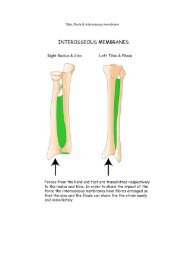GSM 11.14 - Version 5.2.0 - Digital cellular ... - Ttfn.net
GSM 11.14 - Version 5.2.0 - Digital cellular ... - Ttfn.net
GSM 11.14 - Version 5.2.0 - Digital cellular ... - Ttfn.net
Create successful ePaper yourself
Turn your PDF publications into a flip-book with our unique Google optimized e-Paper software.
Page 15<br />
<strong>GSM</strong> <strong>11.14</strong> version <strong>5.2.0</strong>: December 1996<br />
- GET INPUT, which sends text to the display and requests a response in return. It is intended to<br />
allow a dialogue between the SIM and the user.<br />
- MORE TIME, which does not request any action from the ME. The ME is required to respond with<br />
TERMINAL RESPONSE (OK) as normal - see below. The purpose of the MORE TIME command is<br />
to provide a mechanism for the SIM Application Toolkit task in the SIM to request more processing<br />
time.<br />
- PLAY TONE, which requests the ME to play a tone in its earpiece, ringer, or other appropriate<br />
loudspeaker.<br />
- POLL INTERVAL, which negotiates how often the ME sends STATUS commands to the SIM during<br />
idle mode. Polling is disabled with POLLING OFF. Use of STATUS for the proactive SIM is<br />
described in <strong>GSM</strong> 11.11 [14].<br />
- REFRESH, which requests the ME to carry out a SIM initialization according to <strong>GSM</strong> 11.11<br />
subclause 11.2.1, and/or advises the ME that the contents or structure of EFs on the SIM have<br />
been changed. The command also makes it possible to restart a card session by resetting the SIM.<br />
- SELECT ITEM, where the SIM supplies a list of items, and the user is expected to choose one. The<br />
ME presents the list in an implementation-dependent way.<br />
- SEND SHORT MESSAGE, which sends a short message or SMS-COMMAND to the <strong>net</strong>work.<br />
- SEND SS, which sends a SS request to the <strong>net</strong>work.<br />
- SEND USSD, which sends an USSD string to the <strong>net</strong>work.<br />
- SET UP CALL, of which there are three types:<br />
- set up a call, but only if not currently busy on another call;<br />
- set up a call, putting all other calls (if any) on hold;<br />
- set up a call, disconnecting all other calls (if any);<br />
SET UP MENU, where the SIM supplies a list of items to be incorporated into the ME's menu<br />
structure.<br />
- PROVIDE LOCAL INFORMATION which requests the ME to pass local information to the SIM, for<br />
example the mobile country and <strong>net</strong>work codes (MCC + MNC) of the <strong>net</strong>work on which the user is<br />
registered.<br />
The ME tells the SIM if the command was successful or not using the command result procedure defined in<br />
section 6.7. Responsibility for what happens after that (whether to repeat the command, try another one<br />
immediately, try again sometime later, or not to try again at all) lies with the SIM application. However, the<br />
SIM application needs to know why the command failed, so the ME provides the SIM with the result of the<br />
command.<br />
Results are grouped into three main types:<br />
- OK.<br />
- Temporary problem. These results are further broken down into types of temporary problems, and<br />
specific causes. Generally, they indicate to the SIM that it may be worth trying again.<br />
- Permanent problem. These results are again further broken down into types of permanent problems,<br />
and specific causes. Generally, they indicate to the SIM that it is not worth trying again during this<br />
<strong>GSM</strong> session.








